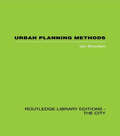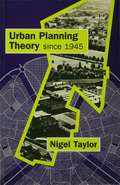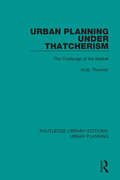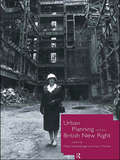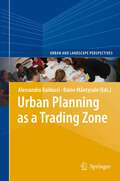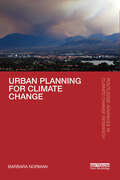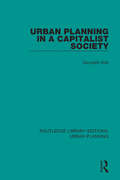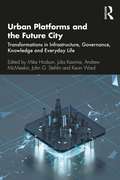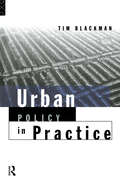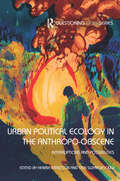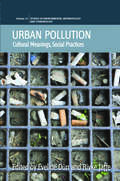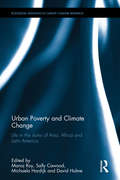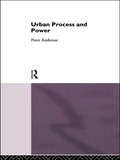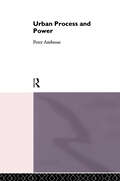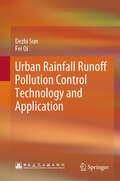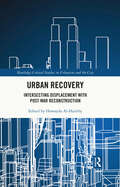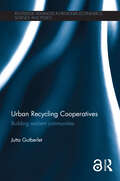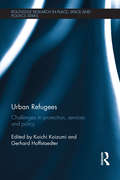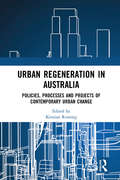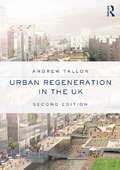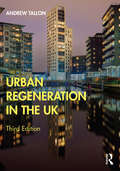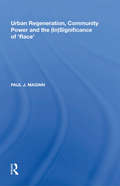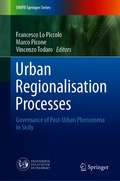- Table View
- List View
Urban Planning Methods: Research and Policy Analysis
by Ian BrackenIn order to develop and exercise their skills urban planners need to draw upon a wide variety of methods relating to plan and policy making, urban research and policy analysis. More than ever, planners need to be able to adapt their methods to contemporary needs and circumstances. This introductory textbook focuses on the need to combine traditional research methods with policy analysis in order to understand the true nature of urban planning processes. It describes both planning methods and their underlying concepts and principles, illustrating applications by reference to the daily activities of planning, including the assessment of needs and preferences of the population, the generation and implementation of plans and policies, and the need to take decisions related to the allocation of land, population change, employment, housing and retailing. Ian Bracken also provides a comprehensive guide to the more specialized research literature and case studies of contemporary urban planning practice. This book was first published in 1981.
Urban Planning Theory since 1945 (Urban Studies)
by Nigel TaylorFollowing the Second World War, modern systems of urban and regional planning were established in Britain and most other developed countries. In this book, Nigel Taylor describes the changes in planning thought which have taken place since then. He outlines the main theories of planning, from the traditional view of urban planning as an exercise in physical design, to the systems and rational process views of planning of the 1960s; from Marxist accounts of the role of planning in capitalist society in the 1970s, to theories about planning implementation, and more recent views of planning as a form of `communicative action′.
Urban Planning Under Thatcherism: The Challenge of the Market (Routledge Library Editions: Urban Planning #21)
by Andy ThornleyOriginally published in 1991, Urban Planning Under Thatcherism links theory and practice to assess the changes to the planning system since 1979. It analyses the major trends by investigating the individual modifications in the legislation and the new initiatives which have introduced procedures to by-pass the normal system. Such changes are fundamental not only to the built environment but to the quality of urban life and ultimately to the nature of society. The book argues that this orientation is the result of a policy shift from local democracy to centralisation and from the criteria of the public interest to those of the market.
Urban Planning and the British New Right
by Huw Thomas Philip AllmendingerDid the 1980s and 1990s see the death of planning?Exposing the myth that has grown up around Thatcherism, leading experts from a wide range of land-use policy areas examine the changes that were brought about in planning and the environment during the 1980s and 1990s, and argue that much less was achieved than expected.Urban Planning and the British New Right questions common assumptions about planning practices under Thatcherism, concluding that the complex relationship of power between central, local and national government requires a sensitivity to change that is inclusive rather than doctrinal. This is a book that says as much about the administration, institutions and processes of planning as it does about Mrs Thatcher's attempts to change it.
Urban Planning as a Trading Zone
by Raine Mäntysalo Alessandro Balducci'Trading zone' is a concept introduced by Peter Galison in his social scientific research on how scientists representing different sub-cultures and paradigms have been able to coordinate their interaction locally. In this book, Italian and Finnish planning researchers extend the use of the concept to different contexts of urban planning and management, where there is a need for new ideas and tools in managing the interaction of different stakeholders. The trading zone concept is approached as a tool in organizing local platforms and support systems for planning participation, knowledge production, decision making and local conflict management. In relation to the former theses of communicative planning theory that stress the ideals of consensus, mutual understanding and universal reason, the 'trading zone approach', outlined in this book, offers a different perspective. It focuses on the potentiality to coordinate locally the interaction of different stakeholders without requiring the deeper sharing of understandings, values and motives between them. Galison's commentary comes in the form of the book's final chapter.
Urban Planning for Climate Change (Routledge Advances in Climate Change Research)
by Barbara NormanThis book tackles the future challenges and opportunities for planning our cities and towns in a changing climate and recommends key actions for more resilient urban futures. Urban Planning for Climate Change focusses on how urban planning is fundamental to action on climate change. In doing so it particularly looks at current practice and opportunities for innovation and capacity building in the future - carbon neutral development, building back better and creating more resilient urban settlements around the world. The complex challenge of possible urban resettlement from the impact of climate change is covered as a special issue bringing a focus on adaptation, working with nature and delivering real action on climate change with local communities. Norman recommends ten essential actions for urban planning for climate change along with some suggestions to inspire the next generations to embrace these opportunities with creativity and innovation. Featuring key messages and implications for practice in each chapter, this book will be of great interest to students, scholars, practitioners and communities involved in planning more climate resilient urban and regional futures.
Urban Planning in Europe: International Competition, National Systems and Planning Projects
by Peter Newman Andy ThornleyUrban planning is undergoing a period of transformation across Europe, with a major trend towards increased urban competition, national deregulation and greater private sector influence.Urban Planning in Europe is the first comprehensive analysis of the influence of countries is developed, presenting the similarities and differences of each country's national planning system. The authors use detailed case studies to explore planning policies in a range of European cities, and discuss the social and environmental objectives that influence today's urban planner.Urban Planning in Europe is an essential guide to contemporary European planning projects and highlighting opportunities for innovation which contain vital lessons for the future of urban decision making.
Urban Planning in a Capitalist Society (Routledge Library Editions: Urban Planning #15)
by Gwyneth KirkOriginally published in 1980, Urban Planning in a Capitalist Society addresses land use planning as both a technical and a political activity, involving the distribution of scarce resources – land and capital. The book reviews and assesses the strengths and weaknesses of several theoretical perspectives, and pluralist, bureaucratic, reformist and Marxist approaches to the distribution of power, and hence resources in a capitalist society. It concentrates on the role played by planning professionals, the opportunity for the public to influence land use planning decision making, and the scope for political action concerning planning.
Urban Platforms and the Future City: Transformations in Infrastructure, Governance, Knowledge and Everyday Life
by Mike Hodson; Julia Kasmire; Andrew McMeekin; John G. Stehlin; and Kevin WardThis title takes the broadest possible scope to interrogate the emergence of “platform urbanism”, examining how it transforms urban infrastructure, governance, knowledge production, and everyday life, and brings together leading scholars and early-career researchers from across five continents and multiple disciplines. The volume advances theoretical debates at the leading edge of the intersection between urbanism, governance, and the digital economy, by drawing on a range of empirically detailed cases from which to theorize the multiplicity of forms that platform urbanism takes. It draws international comparisons between urban platforms across sites, with attention to the leading edges of theory and practice and explores the potential for a renewal of civic life, engagement, and participatory governance through “platform cooperativism” and related movements. A breadth of tangible and diverse examples of platform urbanism provides critical insights to scholars examining the interface of digital technologies and urban infrastructure, urban governance, urban knowledge production, and everyday urban life. The book will be invaluable on a range of undergraduate and postgraduate courses, as well as for academics and researchers in these fields, including anthropology, geography, innovation studies, politics, public policy, science and technology studies, sociology, sustainable development, urban planning, and urban studies. It will also appeal to an engaged, academia-adjacent readership, including city and regional planners, policymakers, and third-sector researchers in the realms of citizen engagement, industrial strategy, regeneration, sustainable development, and transport.
Urban Policy in Practice
by Tim BlackmanUrban Policy and Practice is a practical and critical guide to urban policy in contemporary Britain. The book covers a range of topics including: * Quality and consumerism in the public sector * Community development * Public Health * Environmental issues * Local intervention in the creation of skills and jobs Case studies are drawn from housing, planning, the social services, economic development, and local government finance. Throughout, the concern is for a clear analysis of corporate strategies, democratic control and sustainable development.
Urban Political Ecology in the Anthropo-obscene: Interruptions and Possibilities (Questioning Cities)
by Erik Swyngedouw Henrik ErnstsonUrban Political Ecology in the Anthropo-obscene: Interruptions and Possibilities centres on how to organize anew the articulation between emancipatory theory and political activism. Across its theoretical and empirical chapters, written by leading scholars from anthropology, geography, urban studies, and political science, the book explores new political possibilities that are opening up in an age marked by proliferating contestations, sharpening socio-ecological inequalities, and planetary processes of urbanization and environmental change. A deepened conversation between urban environmental studies and political theory is mobilized to chart a radically new direction for the field of urban political ecology and cognate disciplines: What could emancipatory politics be about in our time? What does a return of the political under the aegis of equality and freedom signal today in theory and in practice? How do political movements emerge that could re-invent equality and freedom as actually existing socio-ecological practices? The hope is to contribute discussions that can expand and rearrange critical environmental studies to remain relevant in a time of deepening depoliticization and the rise of post-truth politics. Urban Political Ecology in the Anthropo-obscene will be of interest to postgraduates, established scholars, and upper level undergraduates from any discipline or field with an interest in the interface between the urban, the environment, and the political, including: geography, urban studies, environmental studies, and political science.
Urban Pollution
by Eveline Da¼rr Rivke JaffeRe-examining Mary Douglas' work on pollution and concepts of purity, this volume explores modern expressions of these themes in urban areas, examining the intersections of material and cultural pollution. It presents ethnographic case studies from a range of cities affected by globalization processes such as neoliberal urban policies, privatization of urban space, continued migration and spatialized ethnic tension. What has changed since the appearance of Purity and Danger? How have anthropological views on pollution changed accordingly? This volume focuses on cultural meanings and values that are attached to conceptions of 'clean' and 'dirty', purity and impurity, healthy and unhealthy environments, and addresses the implications of pollution with regard to discrimination, class, urban poverty, social hierarchies and ethnic segregation in cities.
Urban Poverty and Climate Change: Life in the slums of Asia, Africa and Latin America (Routledge Advances in Climate Change Research)
by David Hulme Manoj Roy Sally Cawood Michaela HordijkThis book deepens the understanding of the broader processes that shape and mediate the responses to climate change of poor urban households and communities in Asia, Africa and Latin America. Representing an important contribution to the evolution of more effective pro-poor climate change policies in urban areas by local governments, national governments and international organisations, this book is invaluable reading to students and scholars of environment and development studies.
Urban Poverty in the Global South: Scale and Nature
by David Satterthwaite Diana MitlinOne in seven of the world’s population live in poverty in urban areas, and the vast majority of these live in the Global South – mostly in overcrowded informal settlements with inadequate water, sanitation, health care and schools provision. This book explains how and why the scale and depth of urban poverty is so frequently under-estimated by governments and international agencies worldwide. The authors also consider whether economic growth does in fact reduce poverty, exploring the paradox of successful economies that show little evidence of decreasing poverty. Many official figures on urban poverty, including those based on the US $1 per day poverty line, present a very misleading picture of urban poverty’s scale. These common errors in definition and measurement by governments and international agencies lead to poor understanding of urban poverty and inadequate policy provision. This is compounded by the lack of voice and influence that low income groups have in these official spheres. This book explores many different aspects of urban poverty including the associated health burden, inadequate food intake, inadequate incomes, assets and livelihood security, poor living and working conditions and the absence of any rule of law. Urban Poverty in the Global South: Scale and Nature fills the gap for a much needed systematic overview of the historical and contemporary state of urban poverty in the Global South. This comprehensive and detailed book is a unique resource for students and lecturers in development studies, urban development, development geography, social policy, urban planning and design, and poverty reduction.
Urban Process and Power
by Peter AmbroseUrban Process and Power has two chief aims. Firstly, it analyses and explains a century of the production and reproduction of the urban environment in which most of us live. Secondly, the book focuses on recent changes in the control of these processes and the ideology that has brought these changes about. Immense disparities exist between the "best" and the "worst" urban areas in Britain. Why do these differences arise and how are they perpetuated? The author argues that the growth of such inequality is linked to questions of accountability and the increasing erosion of a democratic principle in the urban process.
Urban Process and Power
by Peter AmbroseUrban Process and Power has two chief aims. Firstly, it analyses and explains a century of the production and reproduction of the urban environment in which most of us live. Secondly, the book focuses on recent changes in the control of these processes and the ideology that has brought these changes about. Immense disparities exist between the "best" and the "worst" urban areas in Britain. Why do these differences arise and how are they perpetuated? The author argues that the growth of such inequality is linked to questions of accountability and the increasing erosion of a democratic principle in the urban process.
Urban Rainfall Runoff Pollution Control Technology and Application
by Fei Qi Dezhi SunThis book comprehensively presents rapid progress and development in urban rainfall runoff pollution control technology in China since the 11th Five-Year Plan period. It covers many aspects of the research including background summary, assessment methods, control technology, and various case studies to the validation of the control theory and the development of sponge city construction. The book appeals to scholars and graduates majoring in environmental engineering and water supply engineering. It is also suitable for practitioners engaged in urban drainage system.
Urban Recovery: Intersecting Displacement with Post War Reconstruction (Routledge Critical Studies in Urbanism and the City)
by Howayda Al-HarithyThis book calls for re-conceptualising urban recovery by exploring the intersection of reconstruction and displacement in volatile contexts in the Global South. It explores the spatial, social, artistic, and political conditions that promote urban recovery. Reconstruction and displacement have often been studied independently as two different processes of physical recovery and human migration towards safety and shelter. It is hoped that by intersecting or even bridging reconstruction with displacement we can cross-fertilize and exploit both discourses to reach a greater understanding of the notion of urban recovery as a holistic and multi-layered process. This book brings multidisciplinary perspectives into conversation with each other to look beyond the conflict-related displacement and reconstruction and into the greater processes of crises and recovery. It uses empirical research to examine how trauma, crisis, and recovery overlap, coexist, collide and redefine each other. The core exploration of this edited collection is to understand how the oppositional framing of destruction versus reconstruction and place-making versus displacement can be disrupted; how displacement is spatialized; and how reconstruction is extended to the displaced people rebuilding their lives, environments, and memories in new locations. In the process, displacement is framed as agency, the displaced as social capital, post-conflict urban environments as archives, and reconstructions as socio-spatial practices. With local and international insights from scholars across disciplines, this book will appeal to academics and students of urban studies, architecture, and social sciences, as well as those involved in the process of urban recovery.
Urban Recycling Cooperatives: Building resilient communities (Routledge Advances in Regional Economics, Science and Policy)
by Jutta GutberletSolid waste is a major urban challenge worldwide and decisions over which technologies or methods to apply can have beneficial or detrimental long-term consequences. Inappropriate management of solid waste can lead to damaging environmental impacts, particularly in the megacities of the Global South. Urban Recycling Cooperatives explores the multiple narratives and interdisciplinary nature of waste studies, drawing attention to the pressing social, economic and environmental challenges related to waste management. The book asks questions such as: how do we define waste and our relation to it; who is involved in dealing with waste; and what power interactions become manifest over issues of accessing and managing waste? In recent years informal cooperatives have emerged, devoted to recycling household and business waste before reclassifying it and redirecting it to the authorities. Hence, these workers are able to reclaim significant amounts of natural resources and thus contribute to the saving of resources and lessened waste management expenditures. With particular reference to the Brazilian megalopolis of São Paulo, this book describes this paradigm shift in the general understanding of waste as unwanted discard towards the recognition of waste as a resource that must be recovered for reuse or recycling. It would be of interest to students and policy makers working in international development and waste management.
Urban Refugees: Challenges in Protection, Services and Policy (Routledge Research in Place, Space and Politics)
by Koichi Koizumi Gerhard HoffstaedterUrban refugees now account for over half the total number of refugees worldwide. Yet to date, far more research has been done on refugees living in camps and settlements set up expressly for them. This book provides crucial insights into the worldwide phenomenon of refugee flows into urban settings, repercussions for those seeking protection, and the agencies and organizations tasked to assist them. It provides a comparative exploration of refugees and asylum seekers in nine urban areas in Africa, Asia and Europe to examine issues such as status recognition, international and national actors, housing, education and integration. The book explores the relationship between refugee policies of international organisations and national governments and on the ground realities and demonstrates both the diverse of circumstances in which refugees live, and their struggle for recognition, protection and livelihoods.
Urban Regeneration in Australia: Policies, Processes and Projects of Contemporary Urban Change
by Kristian RumingDrawing together leading urban academics, this book provides the first detailed and cohesive exploration of contemporary urban regeneration in Australian cities. It explores the multiple aspects and processes of regeneration, including planning policy (strategic and regulatory), development financing, sustainability, remediation and transport. The book puts forward a unique and innovative ‘scaled’ analysis of urban regeneration, which positions urban regeneration as more than just large-scale redevelopment projects. It examines the processes of urban change which occur outside inner suburbs, which contribute to regenerating the city as a whole. The book moves beyond the planning and economic considerations of the regeneration process to describe the social and cultural aspects of regeneration. In doing so, it focuses on the management of higher-density environments, culture as a trigger for regeneration, and community opposition to the regeneration process. Urban Regeneration in Australia would benefit academics, students and professionals of urban geography and planning, as well as those with a particular interest in Australian urbanism.
Urban Regeneration in the UK
by Andrew TallonStriking transformations are taking place in the urban landscape. The regeneration of urban areas in the UK and around the world has become an increasingly important issue amongst governments and populations since the global economic downturn. This textbook provides an accessible and critical synthesis of urban regeneration in the UK, analyzing key policies, approaches, issues and debates. It places the historical and contemporary regeneration agenda in context. The second edition has been extensively revised and updated to incorporate advances in literature, policy and case study examples, as well as giving greater discussion to the New Labour period of urban policy, and the urban agenda and regeneration policies of the Conservative-Liberal Democrat Coalition government elected in 2010. The book is divided into five sections, with Section I establishing the conceptual and political framework for urban regeneration in the UK. Section II traces policies that have been adopted by central government to influence the social, economic and physical development of cities, including early town and country and housing initiatives, community-focused urban policies of the late 1960s, entrepreneurial property-led regeneration of the 1980s, competition for urban funds in the 1990s, urban renaissance and neighborhood renewal policies of the late 1990s and early 2000s, and new approaches since 2010 which have sought to stimulate enterprise and embrace localism in an age of austerity resulting from the global economic downturn. Section III illustrates the key thematic policies and strategies that have been pursued by cities themselves, focusing particularly on improving economic competitiveness, tackling social disadvantage and promoting sustainable urban regeneration. Section IV summarizes key issues and debates facing urban regeneration in the early 2010s, and speculates upon future directions in an era of economic and political uncertainty. Urban Regeneration in the UK combines the approaches taken by central government and cities themselves to regenerate urban areas, providing a comprehensive and up-to-date synthesis of the field. Each chapter also contains case studies, study questions, suggested further reading and websites, making this an essential resource for undergraduate students interested in Urban Studies, Geography, Planning and the Built Environment.
Urban Regeneration in the UK
by Andrew TallonThis textbook provides an accessible and critical synthesis of urban regeneration in the UK, incorporating key policies, approaches, issues, debates and case studies. The central objective of the textbook is to place the historical and contemporary regeneration agenda in context. Section I sets up the conceptual and policy framework for urban regeneration in the UK. Section II traces policies that have been adopted by central government to influence the social, economic and physical development of cities, including early town and country and housing initiatives, community-focused urban policies of the late 1960s, entrepreneurial property-led regeneration of the 1980s, competition for urban funds in the 1990s, urban renaissance and neighbourhood renewal policies of the late 1990s and 2000s, and new approaches in the age of austerity during the 2010s. Section III illustrates the key thematic policies and strategies that have been pursued by cities themselves, focusing particularly on improving economic competitiveness and tackling social disadvantage. Section IV summarises key issues and debates facing urban regeneration upon entering the 2020s, and speculates over future directions in an era of continued economic uncertainty. The Third Edition of Urban Regeneration in the UK combines the approaches taken by central government and cities themselves to regenerate urban areas. The latest ideas and examples from across disciplines and across the UK's urban areas are illustrated. This textbook provides a comprehensive and up-to-date synthesis that will be of interest to students, as well as a seminal read for practitioners and researchers.
Urban Regeneration, Community Power and the (In)Significance of 'Race'
by Paul J. MaginnThe concepts of community consultation and participation have come to dominate academic and policy debate about urban regeneration partnerships. However, there has been relatively little discussion about the nature of 'community power' within regeneration partnerships. Adopting an ethnographic approach in the study of community participation and power and the significance of 'race' in three ethnically diverse neighbourhoods in London, this book highlights that there has been a 'pluralistic turn' in British urban regeneration policy. Local communities, often portrayed as the least powerful partner within partnerships, are shown to use various strategies to influence decision-making, thus giving rise to a new typology of pluralism - 'pragmatic'; 'hyper-' and 'paternalistic'. Furthermore, the significance of 'race' (and racism) within community forums and regeneration partnerships is challenged. The playful use of the term (In) Significance in the title is linked to the argument that, although racism exists, 'race' does not always matter.
Urban Regionalisation Processes: Governance of Post-Urban Phenomena in Sicily (UNIPA Springer Series)
by Marco Picone Vincenzo Todaro Francesco Lo PiccoloThis book explores the issues of transformation phenomena of the urban dimension (regionalization processes) that traditional scientific literature fails to describe appropriately. So far, scholars have adopted a widespread dominant perspective that proved unable to grasp the essence of post-modern complexities that urban spaces imply. The book provides a taxonomy, in order to describe the rules of these new and peculiar cities, by using the living dimension as a device for the epistemological breaking down of traditional socio-spatial analyses. After a thorough theoretical introduction, it describes two Sicilian case studies that prove particularly relevant to the construction of a new, alternative urban regionalization theory. These two areas, Palermo and South-Eastern Sicily, are described through several aspects, such as the role of migrants and migrations in defining urban regionalization, the power of fiction and the new urban forms that are slowly emerging in Sicily. Overall, this book provides a refreshing view of what Sicily has been and is becoming, by deconstructing most of its clichés and suggesting theoretical perspectives grounded in both quantitative and qualitative analyses.
